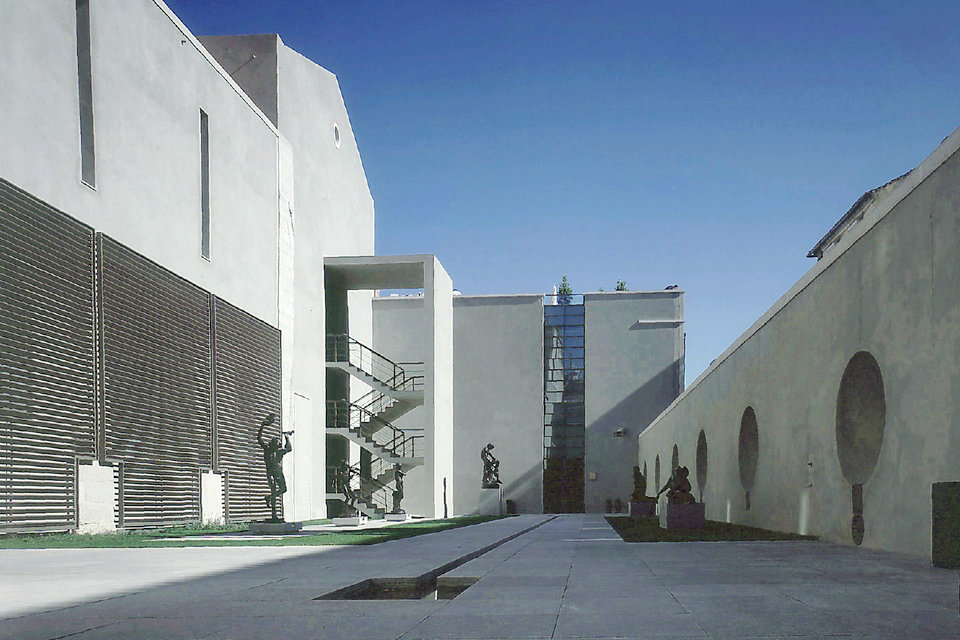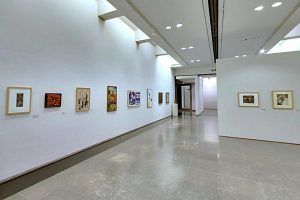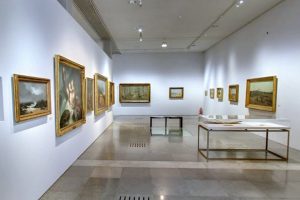The National Museum of Contemporary Art of Portugal (MNAC) is an art museum located in the Chiado neighbourhood of Lisbon, Portugal. It was created in 1911 and re-inaugurated, in new installations, in 1994.
The museum covers the period between 1850 and 1950, with works by the foremost Portuguese artists of the period, as well as some foreigners. It holds the best collection of Portuguese painting and sculpture from the Romanticism, Naturalism, and Modern periods.
The National Museum of Contemporary Art – Museu do Chiado, was one of the first museums of contemporary art being created throughout the world. Located in Lisbon’s historical centre, featuring the leading collection of Portuguese art from the second half of the nineteenth century until the present day the museum is of mandatory visit for the understanding and enjoyment of modern and contemporary Portuguese art. The temporary exhibitions program is of great importance within the overall scope of the museum activities. The presentation of the collection is periodically renewed on their temporal or thematic segments, according to a sustained work of historical and critical research, but the programme is not limited to the Portuguese art, focusing on artists and movements of the international modernism and also monitoring and disseminating contemporary artistic creation, both national and international, through co-productions with other museums and art centers.
The National Museum of Contemporary Art – Museu do Chiado was established by government decree on 26th May 1911. It was born out of the division of the old Museu Nacional de Belas-Artes into the Museu Nacional de Arte Antiga, which inherited from the former all the works produced prior to 1850 and remained in the Palácio das Janelas Verdes, and the National Museum of Contemporary Art, which included all the works completed after that date and was housed in the Convento de S. Francisco, in an area neighbouring the Academia de Belas Artes. The creation of a network of museums, which spread the length of the country, was the fulfilment of a project based on the 18th century concept of human enlightenment, endowing the country with the necessary tools to safeguard and display the nation’s art. The creation of a museum of contemporary art was, in the international context, new and unprecedented.
Among the artists represented are António Silva Porto, António Carneiro, António Soares dos Reis, Miguel Ângelo Lupi, Columbano Bordalo Pinheiro, Amadeo de Souza Cardoso, Abel Manta, Dórdio Gomes, Adriano Sousa Lopes, José de Almada Negreiros, Nadir Afonso, Mário Eloy, Francisco Augusto Metrass, Auguste Rodin, and many others. The museum also hosts temporary exhibitions.
History
Since 1911, the Chiado Museum has occupied part of the old Convent of São Francisco (Saint Francis) in Lisbon, a building of mediaeval origin. The 1994 adaptation and renovation of the museum areas were done by French architect Jean-Michel Wilmotte
The performance of the museum’s first director, the painter Carlos Reis, was low-key. His appointment represented an unexpected triumph for the conservative lobby, to the detriment of the young artists established in Paris. The museum at the time occupied three of its present rooms, and it was entered via the Academia de Belas-Artes. In 1914, the painter Columbano Bordalo Pinheiro became director, continuing and fully developing the traditionalist approach previously adopted, and resisting the shows of displeasure vented by the modernists then centred on the Café Brasileira in Chiado. During his time as director (1914-1929), the museum was expanded to fill several more rooms, one of which was dedicated to sculpture. The painter Adriano de Sousa Lopes, deemed by Columbano the sole artist from amongst the younger generation fit to succeed him, gave continuity to his project and introduced, moderately, some modern elements that he himself was unable to accept. Until 1944, Sousa Lopes would prove to be a bolder director than expected. It was during this period that the modernists finally began to make inroads into the museum’s collections and that important sculptures by Rodin, Bourdelle and Joseph Bernard were acquired. Also during this period, the museum grew, incorporating Columbano Bordalo Pinheiro’s adjacent atelier at the Escola de Belas-Artes, opening thus a new room dedicated to the painter.
It was the sculptor Diogo Macedo who, as director, after extensive remodelling of the structure and interior, opened the museum daily to the public in 1945, with its own entrance in Rua Serpa Pinto. Having been involved in the modernist movement and then later an art historian, his appointment was expected to usher in a new era at the museum. A programme of temporary exhibitions was implemented, as well as research on artists represented in the collection in the form of short monographs published by the museum. However, no clear definition of a modernist stance was forthcoming, and the pernicious commitment to late-naturalism decontextualised from its time was continued. Some works by artists that emerged in the latter half of the 1940s were acquired, though in an unclear and unplanned fashion.
Thus, up until 1959, the museum was outdated and conservative and had little in common with other museums across Europe. The political appointment of the painter Eduardo Malta in that same year, despite general protests by the art community and critics, nevertheless placed further emphasis on a backward-looking approach that had catastrophic consequences for the collection’s modernist position and its respective and necessary adjustment to the international art scene. A catalogue was produced, but the nazi principles on which the collection’s presentation lay was heavily condemned by the leaders of the very regime that had appointed the director in the first place. In 1970, Maria de Lourdes Bártholo, a conservative by training, was appointed director of the museum, which was in an advanced state of disrepair. Over the following 17 years, the building only underwent some very superficial restoration work. The collection extended up to the contemporary era, but the criteria governing representation of the diverse movements, trends and leading figures in Portuguese art, which from the preceding decade onwards had undergone profound quantitative and qualitative transformations, were not in the least equated and neither did the museum’s acquisitions define a consistent and broad understanding of contemporaneity.
With the Chiado fire in August 1988, and even though the museum escaped unscathed, the works of art were removed as a precautionary measure. It was decided by the then secretary of State for Culture, Teresa Gouveia, that the collection’s home should be rethought. The French government put forward a project to renovate the museum by the architect Jean-Michel Wilmotte, who, with a team led by the art historian Raquel Henriques da Silva, redefined the museum in the form it has exhibited since its re-inauguration on 12th July 1994.
The project sought to integrate the building’s existing historically important spaces into a neo-modern architectural language, enhancing the autonomy of the planes that constitute the suspended walkways, the floor itself and the ceilings and the sudden walls that define great vertical extensions. With an original and economic range of materials and colours, its discreet austerity establishes a full dialogue with the building’s functions.
When the museum reopened, a catalogue entitled Museu do Chiado, Arte Portuguesa 1850-1950, produced by Pedro Lapa, Raquel Henriques da Silva and Maria de Aires Silveira, presented the most consistent and coherent nuclei of its extensive collection, over two thousand items, with individual studies on each work, as well as respective bibliographies and historical backgrounds. Given the collection’s failings with regard to its representation of art from the latter half of the twentieth century, the museum’s acquisitions policy focused on the seminal works of the movements of that period. A systematic programme of temporary exhibitions on Portuguese artists that had emerged during the least well represented decades in the collection was put into place, alongside a strong emphasis on the studies and research presented in the respective catalogues. A programme of contemporary art aimed at emerging artists, whose work was based on interpretations of the museum’s collection, was set up and allowed the acquisition of varied works that initiated an updating of the collection’s body of contemporary art. Since the reopening, the museum’s lack of space, both for the collection and the temporary exhibitions, has become notorious.
At the end of 1998, Pedro Lapa, a member of the museum’s reorganisational team, became director. The programme of temporary exhibitions took on greater importance and the focus moved to four specific areas, directly or indirectly related to the chronological scope of the collection. Thus was begun a series of retrospective exhibitions on 19th century Portuguese artists. Continued were the museum’s large retrospectives on Portuguese modernist movements and artists, with the first catalogue raisoneé on a Portuguese artist, Joaquim Rodrigo. In parallel, large exhibitions on the artists and movements at the historical forefront were co-produced with other prestigious international museums. The Interferências (1998-2002) programme ran parallel to the above exhibitions and presented work specifically produced for it by contemporary Portuguese and international artists. Another aspect to which this programme gave particular importance was the format of the publications that accompanied the exhibitions and that presented in-depth scientific and essayistic analysis.
The acquisitions policy has been developed along two lines in order to mitigate the shortcomings referred to in the collection, and the 1950s and 1960s, as well as the 1990s, are now already significantly well represented. A start was also made at incorporating other artistic genres into the collection, such as photography and video, media which are heavily exploited in contemporary art. Several of the museum’s custodians more actively involved in giving the Museu do Chiado – National Museum of Contemporary Art the resources its title would suggest have greatly contributed to this process.
The lack of space has been one of the factors that has most hampered the implementation of the wide range of activities that the museum has sought to develop. The chance to exhibit its collections in a continuous manner, or to develop temporary exhibitions of the scale desired, or even develop pedagogic activities, all these aspects of a museum’s activity are subject to limitations for which a solution is long overdue.
Architecture
Housed since its foundation in 1911 in the São Francisco da Cidade monastery, which was heavily damaged in the 1755 earthquake, the current National Museum of Contemporary Art – Museu do Chiado was re-opened in 1994 following a fire that damaged the area in 1988 and after the completion of renovation work by the French architect Jean-Michel Wilmotte.
The museum atrium serves both as entrance and visitor reception area and reveals the general design adopted for the complex: a neo-modern architectural style that respected the pre-existing historical vestiges – a monastic structure dating from the post-earthquake reconstruction period that was later acquired, following the abolition of the religious orders in 1834, by the English merchant Abraham Wheelhouse. The atrium reveals two lias pillars that support a six-sided brick vault in an austerity of constructed line that falls within the tradition of Portuguese plains architecture. The renovation work respected and enhanced these vestiges, exploiting the high ceiling through the addition of a suspended platform that provides an intermediate floor presently used to exhibit sculpture. The suspended walkway and access stairs, reception desk, sign panels, glass display cases, furniture, lighting systems and supports for the art works were all designed by Wilmotte, who made use of materials such as stone, metal and wood, alongside an ash-grey colour scheme, enhanced by the polished dark blue stone from Cascais used for the floor.
Ash-grey predominates in the subsequent and upper room, used to exhibit sculpture, whose high vertical opening amplifies illusorily the museum’s small exhibition space. Via a stone staircase, the visitor reaches the building’s second floor. Here one enters the Sala dos Fornos (Oven Room), originally constructed between 1830 and 1840 by Abraham Wheelhouse, who at the time equipped it with a series of notable brick ovens. The quadrangular opening in the floor that connects to the lower hallway, currently clad with rock glass, was almost certainly intended for lifting and moving flour.
A new flight of stairs leads to a quadrangular gallery that opens into the sculpture room and allows access to both the upper administrative offices and terrace, with views over the river, and the other exhibition area, two longitudinal galleries joined in an ‘L’ and intersected by narrow shafts of natural light.
From the following gallery one reaches an annexed room, an experimental space lined in wood where natural and artificial light alternate.
Adjoining this room are the library and the Gabinete de Desenhos (Drawing Room), the two areas where the monastic legacy is possibly most evident, for instance in the vaulted ceilings and the twin pillars, which stand out amid the array of technical equipment.
Concluding the tour, the visitor descends via a suspended staircase to the café and enters the open terrace and garden with its display of 19th- and 20th-century bronze sculpture. From the garden, one returns, through a glass door, to the suspended walkway of the atrium and from there down to the reception area.
Collection
The National Museum of Contemporary Art – Museu do Chiado’s collection crosses the history of Portuguese art from the second half of the 19th century until today, constituting a compulsory point of reference for those interested in its study.
The start of the collection is marked by the emergence of Romanticism, in the mid-19th century. Artists such as Tomás da Anunciação and Cristino da Silva convey the romantic spirit through colossal landscapes, rustic and vibrant settings and twilight background lighting. Animalism and portraiture, whose greatest exponents were Anunciação and Luiz de Menezes, complete the romantic themes. The portrait in Miguel Ângelo Lupi’s work has also been reconsidered from a realistic perspective.
A moment of renewal was experienced with the introduction, by Silva Porto and Marques de Oliveira, of research into the possibilities of natural light, updating the understanding of nature and the way it had been approached pictorially. The landscape rendered as observed was the main area of experimentation in Naturalism, alongside the portrait, which finds its finest expression in the work of António Ramalho and, above all, Columbano Bordalo Pinheiro.
Introducing new artistic elements, the Symbolism of António Carneiro and Sousa Lopes marks the transition to the 20th century, which began with a brief but striking outburst of avant-gardism, best exemplified by the work of Amadeo de Souza-Cardoso, the near unique work of Santa Rita and the Orphism of Eduardo Viana. Other courses of renewal were defined by the Expressionism of Mário Eloy in the 1920s and the Dimensionism and Surrealism that António Pedro developed in the 1930s, establishing a link to the later young surrealists of the 1940s.
Alongside these innovative studies, Portuguese Modernism, defined by an ‘indispensable balance’ consistent with the ‘politics of the spirit’ of António Ferro, was being developed by a group of artists. Thus, Almada Negreiros, Dordio Gomes, Abel Manta, Bernardo Marques, Carlos Botelho and Viana and Eloy themselves, and the sculptors Canto da Maia, Diogo de Macedo and Francisco Franco based their research on a classicism that took its fundamental references from Cezánne’s volumetric organisation and the work of Picasso’s classic period.
Political concerns remained outside artistic expression until the Neo-realism of the 1940s, when a group of artists, amongst whom Manuel Filipe and Júlio Pomar stand out, gave social critique a formal shape through expressive distortion. At the same time, Surrealism developed, which re-updated the artistic discourse through experimentation and chance in the production processes. António Dacosta, Marcelino Vespeira, Fernando Lemos, Fernando de Azevedo, Jorge Vieira and Mário Cesariny were the movement’s main protagonists. Abstract Art, introduced in 1944 by Fernando Lanhas, completes this panorama. Lanhas worked alone until Jorge Vieira in sculpture and Nadir Afonso and Joaquim Rodrigo in painting also developed an interest in abstraction.
The 60s and 70s consolidated a break, in artistic terms, from the updating of pressuppositions and methods. The avantgarde spirit was reclaimed and the artists and trends that concerned them multiplied, ranging from New Figuration in the works of Paula Rego and Joaquim Rodrigo, to the New Abstraction that objectifies the painting of Jorge Pinheiro, the experimentation on the object conducted by several members of the KWY group, in particular Lourdes Castro and René Bértholo, the adaptation of Pop Art to the Portuguese context by Sá Nogueira, the examination of issues of perception by Noronha da Costa and Jorge Martins, the research into signs by António Sena and João Vieira, and the pressuposition-bound work of the externally dominant Land Art and Post-conceptual movement, amongst whom Alberto Carneiro, Helena Almeida and Julião Sarmento stand out. The return to painting, to the forms and to the expressionism experienced in the 80s, as well as other internationally pregnant issues relating to the image and its identity, are represented in the collection through the work of the decade’s foremost artists: Júlia Ventura, José Pedro Croft, Julião Sarmento, Jorge Molder, Pedro Cabrita Reis and Rui Sanches.
Authorship, deviation and similarity are the themes expressed in the work of João Penalva, who, along with the romanticism of Rui Chafes and the critical conscience of the Homeostético group, makes the transition to the 90s, marked by different but consuming concerns (Ângela Ferreira, João Tabarra, Miguel Palma, Augusto Alves da Silva), in establishing a reflexive dialogue with politically, socially and culturally compromised statements. In a constant process of updating, the collection contains examples of very recently produced work by artists at the forefront of 21st century art, such as Alexandre Estrela, João Onofre and João Pedro Vale.



